Start HONDA CIVIC 2003 7.G User Guide
[x] Cancel search | Manufacturer: HONDA, Model Year: 2003, Model line: CIVIC, Model: HONDA CIVIC 2003 7.GPages: 1139, PDF Size: 28.19 MB
Page 43 of 1139
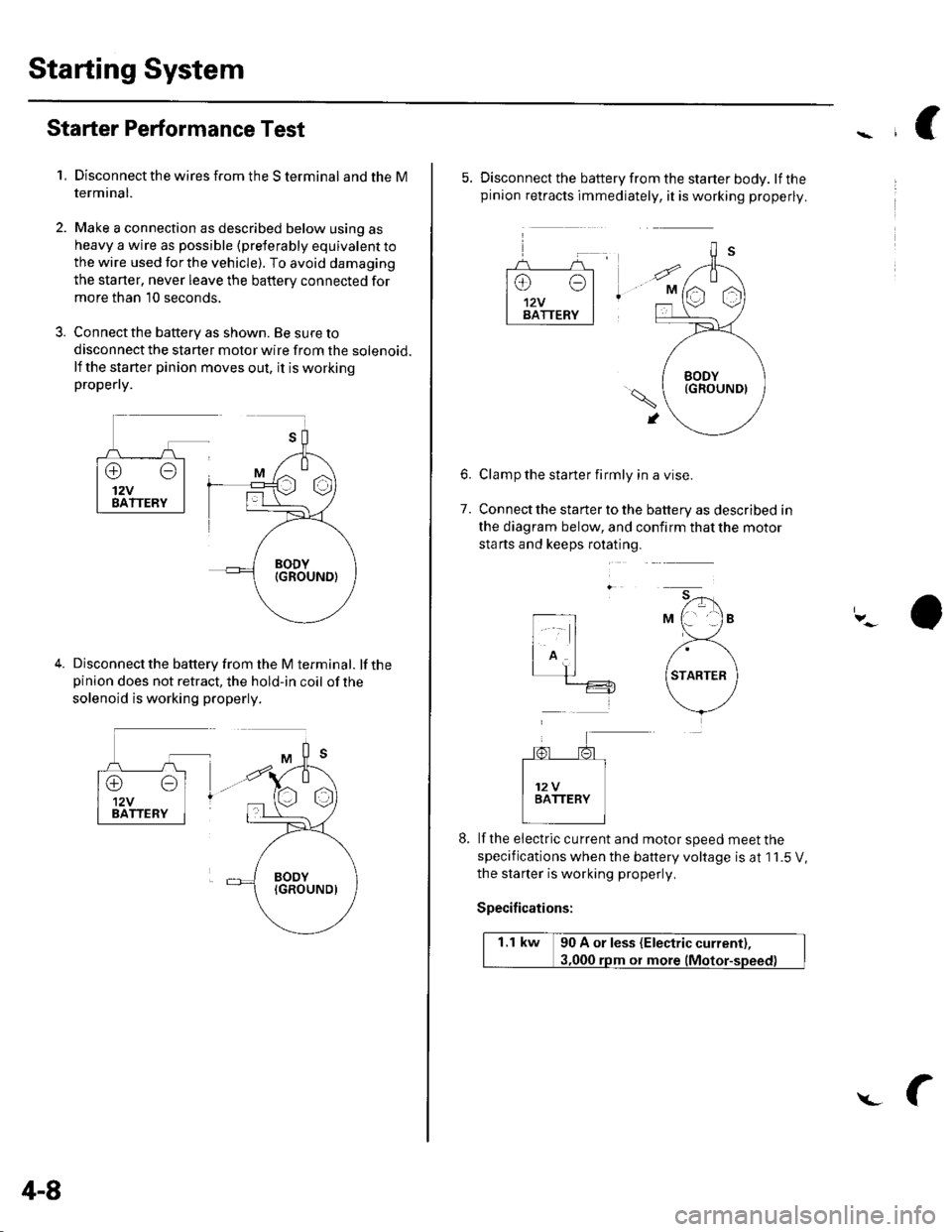
Starting System
Starter Performance Test
1,Disconnect the wires from the S terminal and the M
termrnal.
Make a connection as described below using as
heavy a wire as possible (preterably equivalent to
the wire used for the vehicle). To avoid damaging
the starter, never leave the battery connected for
more than 10 seconds,
Connect the battery as shown. Be sure to
disconnect the starter motor wire from the solenoid.
lf the starter pinion moves out, it is workingpropefly.
Disconnect the battery from the M terminal. lf thepinion does not retract, the hold-in coil of the
solenoid is working properly.
4-8
L
5. Disconnect the battery from the starter body. lfthepinion retracts immediately, it is working properly.
Clamp the starter firmly in a vise.
Connect the starter to the battery as described in
the diagram below, and confirm that the motor
sta rts and keeps rotating.
6.
7.
lf the eiectric cu rrent and motor speed meet the
specifications when the battery voltage is at 1 1.5 V,
the staner is working properly,
Specifications:
1.1 kw 90 A or less (Electric current),
ot more
Page 44 of 1139
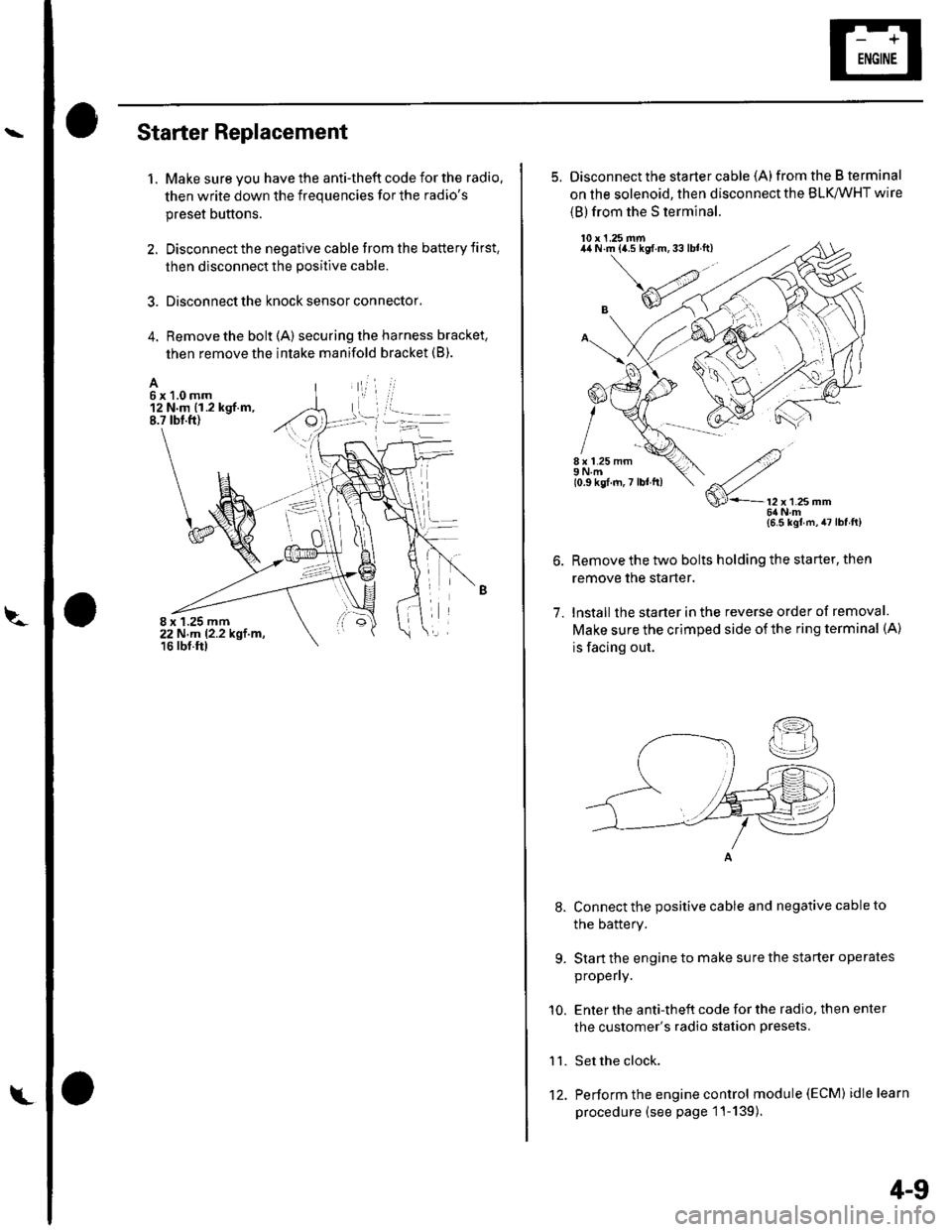
Starter Replacement
1. Make sure you have the anti-theft code for the radio.
then write down the frequencies for the radio's
preset buttons.
2. Disconnect the negative cable from the battery first,
then disconnect the positive cable.
3. Disconnect the knock sensor connector.
4. Remove the bolt (A) securing the harness bracket,
then remove the intake manifold bracket (B).
A6x1,0mm12 N.m {1.2 kgf.m,8.7 tbt.ft)
8 x 1.25 mm22 N,m 12.2 kgt.m,16 rbf.ftl
L't2.
4-9
5. Disconnect the starter cable (A)from the B terminal
on the solenoid, then disconnect the BLK,/WHT wire
{B) from the S terminal.
10 x 1.25 mm44 N.m {a.5 kgf.m,33lblft)
8 x 1.25 mm9Nm10.9 kgf.m,7 lbl ft)
7.
9.
'10.
11.
2
S'-12x12smm6ilNm{6.5 kgl m,47lbfft)
Remove the two bolts holding the starter, then
remove the starter.
lnstall the starter in the reverse order of removal.
Make sure the crimped side of the ring terminal (A)
is facing out.
Connect the positive cable and negative cable to
the batterY.
Start the engine to make sure the starter operates
propeny.
Enter the anti-theft code for the radio, then enter
the customer's radio station presets.
Set the clock.
Perform the engine control module (EcM) idle learn
procedure (see page 1 '1- 139 ).
I
Page 45 of 1139
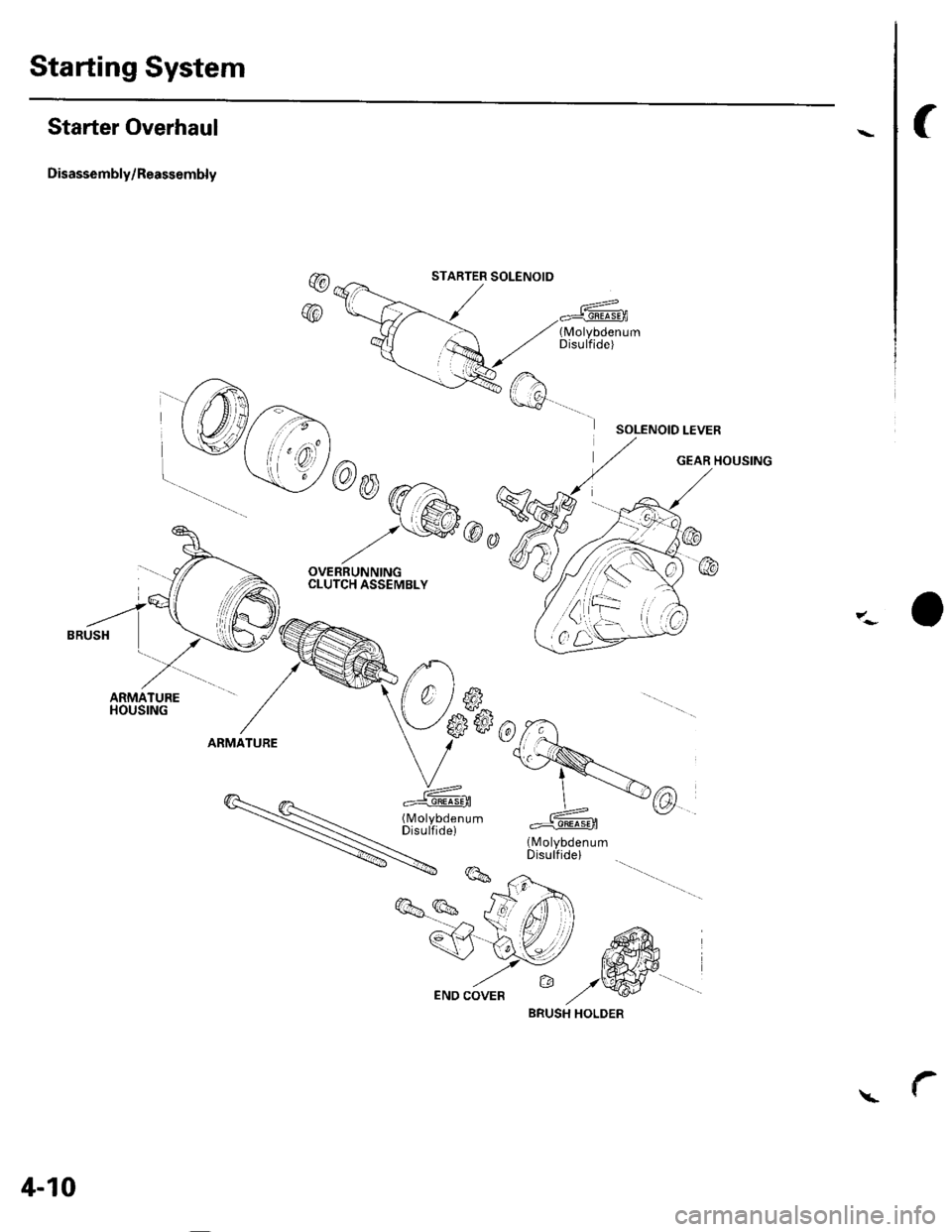
Starting System
Starter Overhaul
Disassembly/Reassembly
f
@
@
,-- ----_2<-
; ,/ 1(-\
rw.h
\:!@a
-
@-A
q -z\hsc6
b-.- ,"OVERRUNNINGCLUTCH ASSEMBLY
G
SOLENOID LEVER
o*"lu*.
V*rN*
\#. A*@
c^)* -#""Jli[X:""
S#o
7:- o
a<-4 t^ fr/ / ffiA-v
9\:-/ ffitr,.. D lWEND COVER t/ '!4/
STARTER SOLENOID
4-10
BRUSH HOLDER
Page 46 of 1139
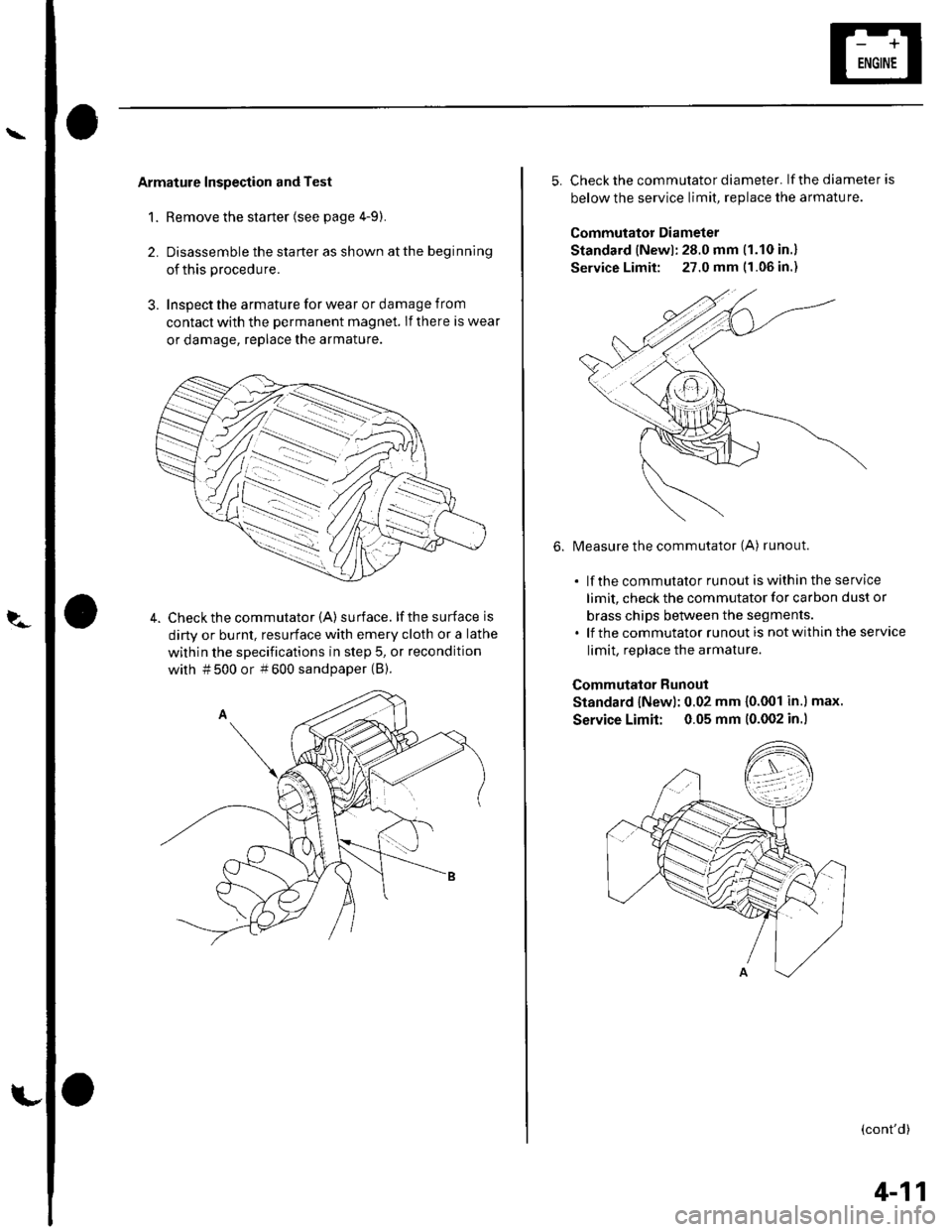
\
?.-
Armature Inspection and Test
1. Remove the starter (see page 4-9).
2. Disassemble the starter as shown atthe beginning
of this procedure.
3. Inspect the armature for wear or damage from
contact with the permanent magnet. lf there is wear
or damage, replace the armature.
Check the commutator (A) surface. lf the surface is
dirty or burnt, resurface with emery cloth or a lathe
within the specifications in step 5, or recondition
with # 500 or # 600 sandpaper (B).
6.
5. Check the commutator diameter. lf the diameter is
below the service limit, replace the armature.
Commutator Diameter
Standard (Newl: 28.0 mm (1.10 in.l
Service Limit: 27.0 mm (1.06 in.)
Measure the commutator (A) runout.
. lf the commutator runout is within the service
limit, check the commutator for carbon dust or
brass chips between the segments.. lf the commutator runout is not within the service
limit, reolace the armature.
Commutator Runout
Standard lNew): 0.02 mm 10.001 in.) max.
Service Limit: 0.05 mm (0.002 in.)
(cont'd)
4-11
Page 47 of 1139

Starting System
Starter Overhaul (cont'dl
7. Check the mica depth (A). lf the mica is too high {B),undercut the mica with a hacksaw blade to theproper depth. Cut away allthe mica (C) between
the commutator segments. The undercut should
not be too shallow, too narrow, or V-shaped (D).
Commutator Mica Depth
Standard (New): 0.50-0.80 mm {0.020-0.031 in.)
Service Limit: 0.20 mm (0.008 in.)
Check for continuity between the segments of the
commutator. lf an open circuit exists between any
segments, replace the armature.
M
4-12
\
9. Place the armature (A) on an armature tester (B).
Hold a hacksaw blade (C) on the armature core. lf
the blade is attracted to the core or vibrates while
the core is turned, the armature is shoned. Replace
the armature.
Check with an ohmmeter that no continuity exists
between the commutator (A) and armature coll
core (B), and between the commutator and
armature shaft (C). lf continuity exists, replace the
armature.
10,
Page 48 of 1139
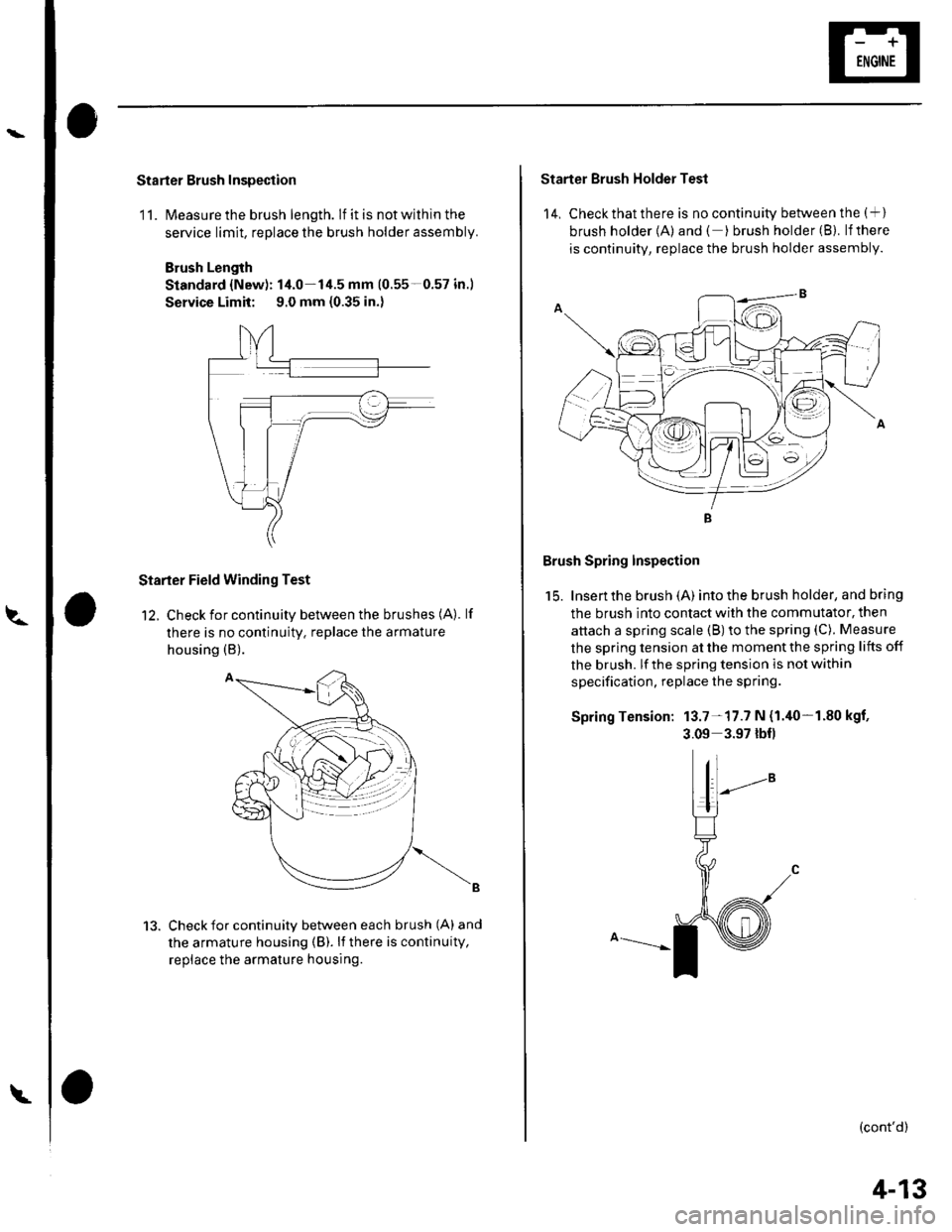
Starter Brush Inspection
11. lvleasure the brush length. lf it is not within the
service limit, replace the brush holder assembly.
Brush Length
Standard {New): 14.0-14.5 mm (0.55-0.57 in.)
Service Limit: 9.0 mm {0.35 in.)
Starter Field Winding Test
12. Check for continuity between the brushes (A). lf
there is no continuity. replace the armature
housing (B).
Check for continuity between each brush (A) and
the armature housing (B). li there is continuity,
replace the armature housing.
13.
Starter Brush Holder Test
14, Check that there is no continuity between the (+ )
brush holder {A) and ( ) brush holder (B}. lfthere
is continuity, replace the brush holder assembly.
Brush Spring Inspection
15. Insen the brush (A) into the brush holder, and bring
the brush into contact with the commutator, then
attach a spring scale (B) to the spring (C). Measure
the spring tension at the moment the spring lifts off
the brush. lf the spring tension is not within
specification, replace the spring.
Spring Tension: 13.7-17.7 N {1.40-1.80 kgf,
3.09 3.97 lbf)
(cont'd)
4-13
Page 49 of 1139
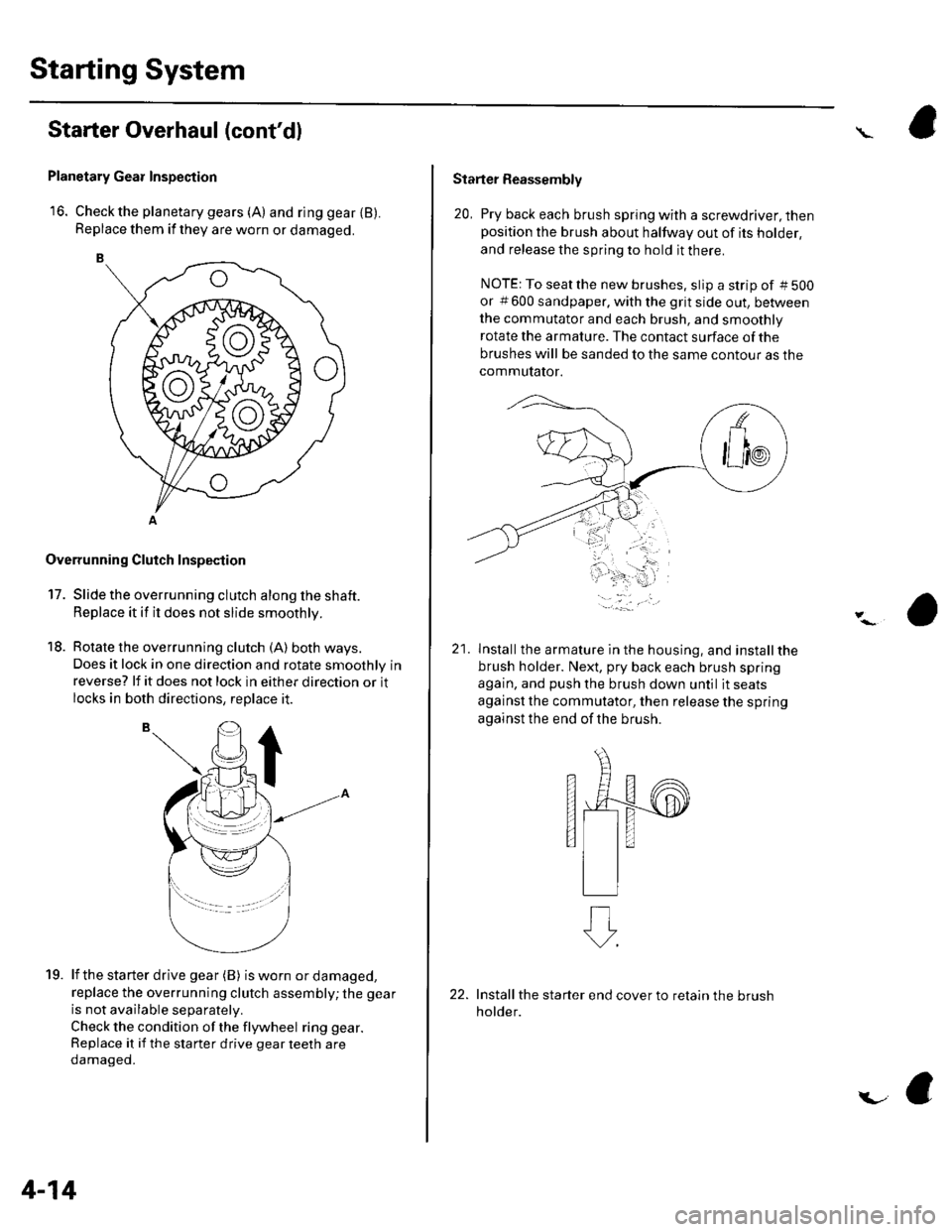
Starting System
Starter Overhaul (cont'dl
Planetary Gear Inspection
16. Check the planetary gears (A) and ring gear {B).Replace them if they are worn or damaged.
Overrunning Cluich Inspection
17. Slide the overrunning clutch along the shaft.
Replace it if it does not slide smoothly.
18. Rotate the overrunning clutch (A) both ways.
Does it lock in one direction and rotate smoothly inreverse? lf it does not lock in either direction or it
locks in both directions, replace it.
lf the starter drive gear (B) is worn or damaged,
replace the overrunning clutch assembly; the gear
is not available separately.
Check the condition of the flywheel ring gear.
Replace it if the starter drive gear teeth are
oamageo.
19.
4-14
i.-
Starter Reassembly
20, Pry back each brush spring with a screwdriver, thenposition the brush about halfway out of its holder,
and release the spring to hold it there.
NOTE: To seatthe new brushes. slip a strip of #5OO
or # 600 sandpaper. with the grit side out, be&veen
the commutator and each brush, and smoothly
rotate the armature. The contact surface of the
brushes will be sanded to the same contour as the
commutator.
21lnstallthe armature in the housing, and installthe
brush holder. Next, pry back each brush spring
again, and push the brush down until it seats
against the commutator, then release the spring
against the end of the brush.
s
Install the starter end cover to retain the brush
holder.
Page 52 of 1139
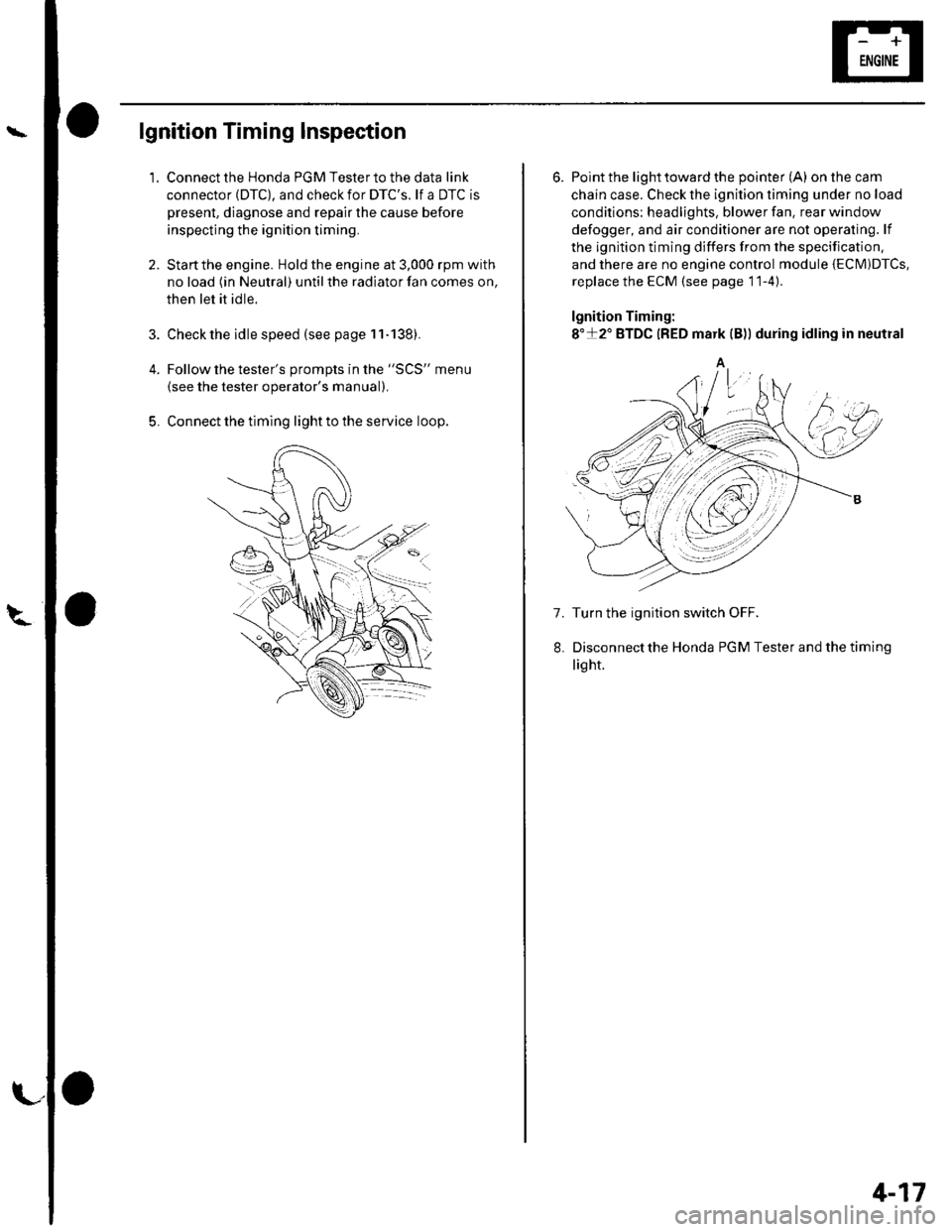
lgnition Timing Inspection
1.
4.
5.
Connect the Honda PGM Tester to the data link
connector (DTC), and check for DTC'S. lf a DTC is
present, diagnose and repair the cause before
inspecting the ignition timing.
Startthe engine. Hold the engine at 3,000 rpm with
no load (in Neutral) until the radiator fan comes on,
then let it idle.
Check the idle speed (see page 11-138).
Follow the tester's prompts in the "SCS" menu
{see the tester operator's manual),
Connect the timing light to the service loop.
o
6. Point the light toward the pointer (A) on the cam
chain case. Check the ignition timing under no load
conditions: headlights, blower fan. rear window
defogger, and air conditioner are not operaling. lf
the ignition timing differs from the specification,
and there are no engine control module {ECM)DTcs,
replace the ECM (see page 11-4)
lgnition Timing:
8"+2" BTDC {RED mark {B)) during idling in neutral
A
7. Turn the ignition switch OFF.
Disconnectthe Honda PGM Tester and thetiming
light.
4-17
Page 57 of 1139
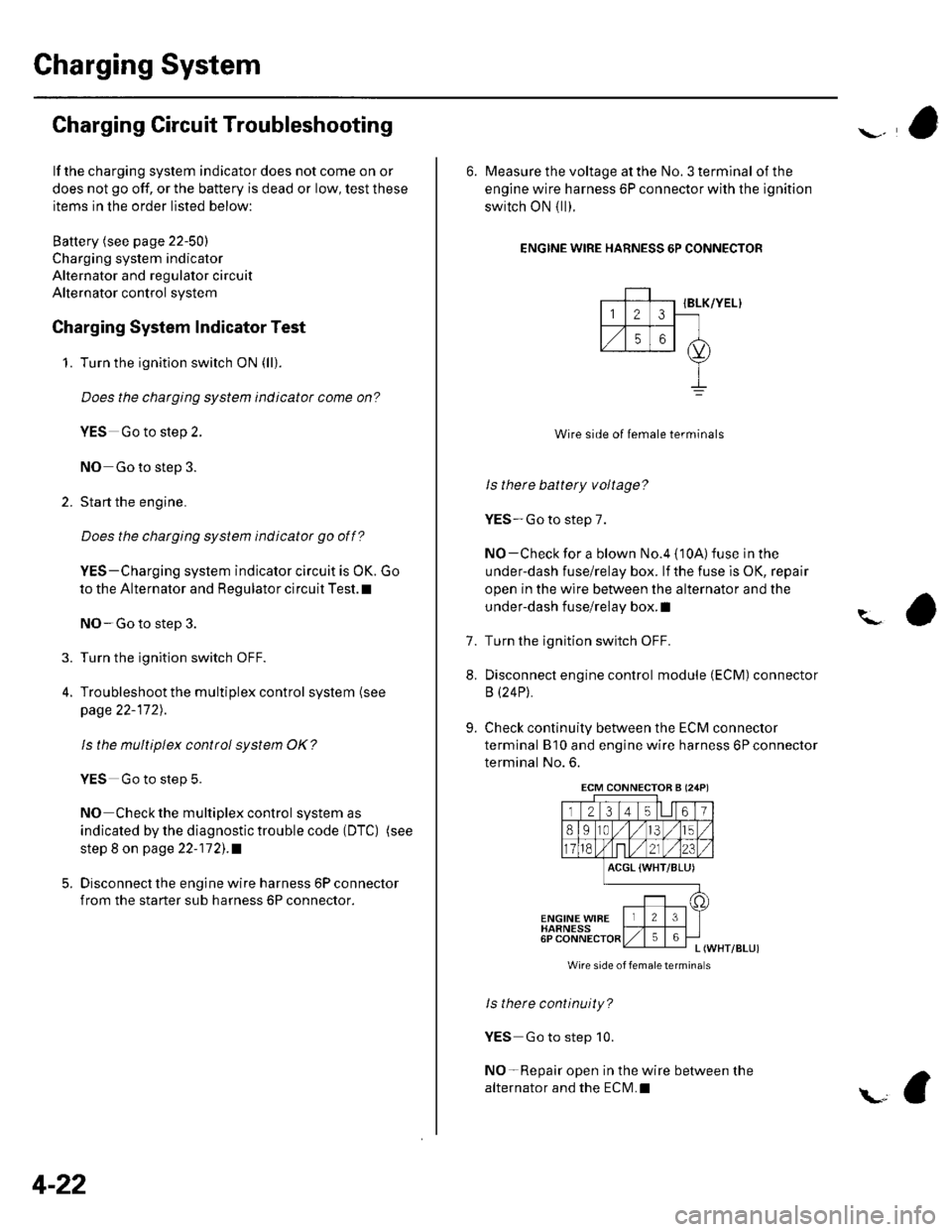
Gharging System
Charging Circuit Troubleshooting
lf the charging system indicator does not come on or
does not go off, or the battery is dead or low, test these
items in the order listed below:
Battery (see page 22-50)
Charging system indicator
Alternator and regulator circuit
Alternator control system
Charging System Indicator Test
1. Turn the ignition switch ON {ll).
Does the chatging system indicator come on?
YES Go to step 2.
NO Go to step 3.
2. Start the engine.
Does the charging system indicator go off?
YES-Charging system indicator circuit is OK. Go
to the Alternator and Regulator circuit Test. t
NO-Go to step 3.
3. Turn the ignition switch OFF.
4. Troubleshoot the multiplex control system (see
page 22 172).
ls the multiplex control system OK?
YES Go to step 5.
NO Check the multiplex control system as
indicated by the diagnostic trouble code (DTC) (see
step 8 on page 22-172).1
5. Disconnect the engine wire harness 6P connector
from the starter sub harness 6P connector.
4-22
\"4
6. Measure the voltage at the No. 3 terminal of the
engine wire harness 6P connector with the ignition
switch ON { ll).
ENGINE WIRE HARNESS 6P CONNECTOR
IBLK/YEL}
Wire side of female terminals
ls there battery voltage?
YES-Go to step 7.
NO-Check for a blown No.4 {10A) fuse in the
under-dash fuse/relay box. lf the fuse is OK, repair
open in the wire between the alternator and the
under-dash fuse/relay box. I
Turn the ignition switch OFF.
Disconnect engine control module (ECM) connector
B (24P).
Check continuity between the ECM connector
terminal B'10 and engine wire harness 6P connector
terminal No. 6.
?
7.
8.
9.
ACGL {WHT/BLU)
ENGINE WIBEHARNESS6PL (WHT/BLUI
Wire side of femaletermina s
ls there continuity?
YES Go to step 10.
NO-Repair open in the wire between the
alternator and the ECN4.I
ECM CONNECTOB A (24P)
Page 58 of 1139
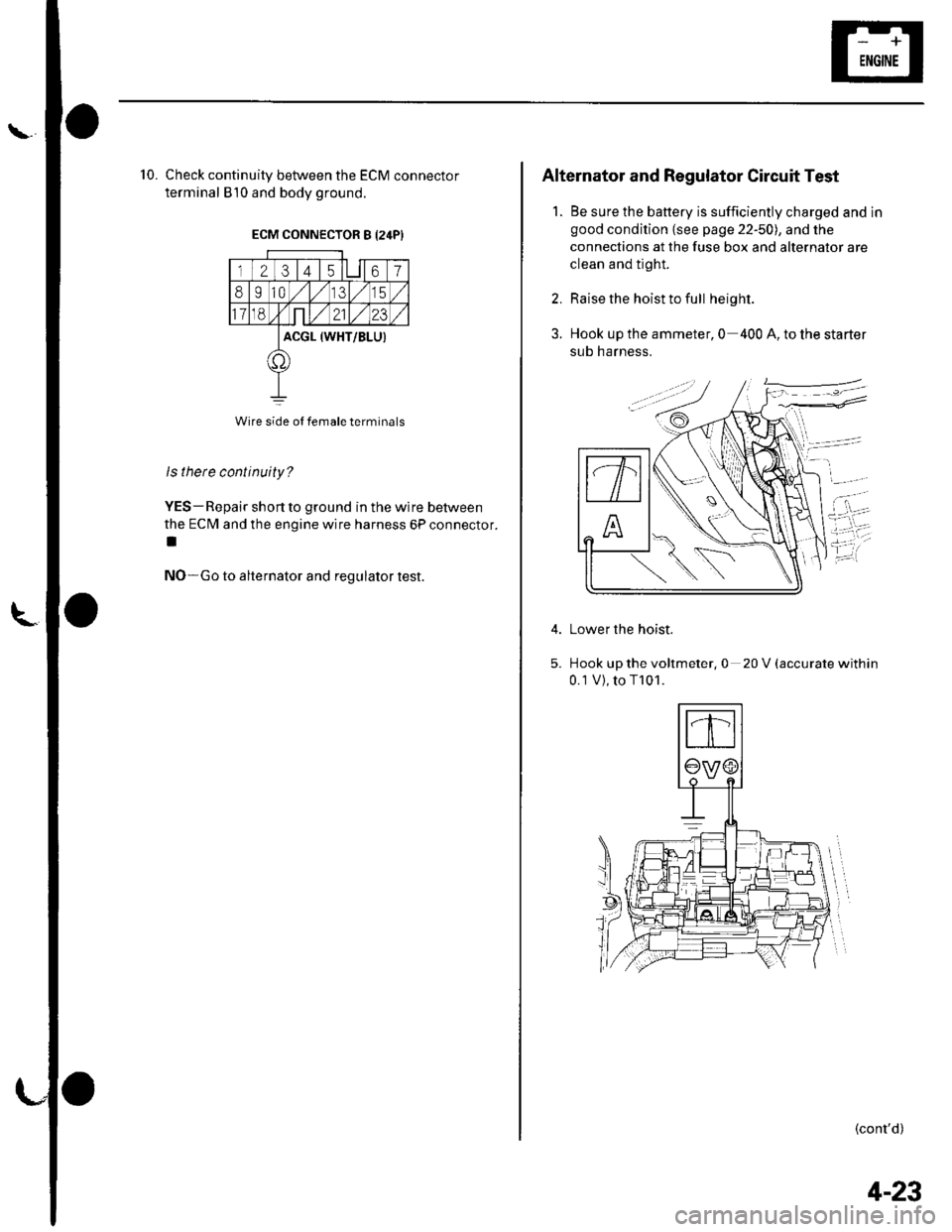
'10. Check continuity between the ECM connector
terminal 810 and body ground.
ECM CONNECTOR S I24PI
23 t4 t567
8I10,/1,/315
118,Nnt,/2123
ACGL (WHT/BLUI
t1'
Wire side ol female terminals
ls there continuity?
YES- Repair short to ground in the wire between
the ECM and the engine wire harness 6P connector.
t
NO-Go to alternator and regulator test.
Alternator and Regulator Circuit Test
1. Be sure the battery is sufficiently charged and in
good condition {see page 22-50), and the
connections at the fuse box and alternator are
clean and tight.
2. Raise the hoist to full height.
3. Hook up the ammeter, 0 400 A, to the starter
sub harness.
Lower the hoist.
Hook up the voltmeter, 0 20 V (accurate within
0.1V),toT101.
(cont'd)
4-23